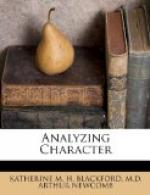The child or adult of unusual ability, with well-marked inclinations and strong in the fundamentals of character, is never difficult to analyze, counsel, train, or place. If given an opportunity to gain knowledge, and freedom in the exercise of choice, he will almost surely gravitate into his natural line of work. He is not the real problem of the vocational expert. But the vast majority of children are average, or even mediocre. They show little inclination toward any study or any work. They have weaknesses of character that will inevitably handicap them, no matter what vocation they enter. They are the real problem. There is another class, almost equally distressing. They are the people who are brilliant, who learn easily, and who are so adaptable that they can turn their hands to almost anything. They are usually so unstable in temperament that it is difficult for them to persist in any one kind of endeavor long enough to score a success.
METHODS OF ANALYSIS IN USE
The need, in dealing with these problems, for some more reliable guide than the young person’s inclinations and preferences has deeply impressed itself upon those engaged in vocational study and vocational work. They are earnestly seeking to find some better way. To this end, we have the questionaire, by which is brought out between the lines, as it were, the particular aptitudes and disposition of the subject. And this method is not without its advantages. We have also psychological tests. These are of fascinating interest and have yielded some valuable results. Some vocational workers use the psychological tests and some do not. Even those who are most enthusiastic for them admit that they are complicated, that they require expensive apparatus and specially trained examiners, and that even the best results obtainable cover a very narrow field in the character and aptitudes of the subject.
UNIFORM METHOD NEEDED
The present need is for some uniform, readily applicable, inexpensive, and comprehensive method of analysis. The advantages of such a method are immediately apparent. First, its uniformity would permit the making of records for comparison, covering a very wide range of subjects, environment, and vocations. Second, even the simplest classifications, which are readily learned and easily applied by the inexpert, would yield tangible and measurable results and would be far better than the present unstandardized and wholly unscientific methods. Third, were such a uniform method adopted and made a part of the vocational work of our institutions; were uniform records to be made and wisely used, we should soon have a body of useful knowledge on this subject. Fourth, as the result of the application of such a uniform method, text books and charts could be prepared which would form the basis of popular education in vocational guidance.




